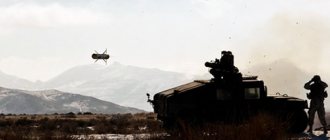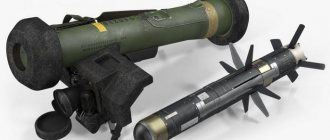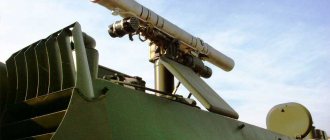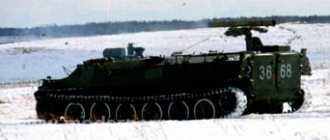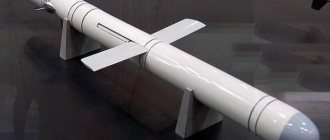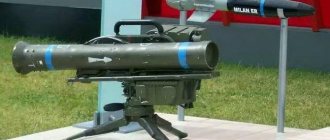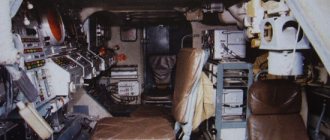World War II is often called the “War of Motors,” and this is absolutely true. Tanks were the main striking force of that conflict. Already in the second half of the war, it became clear that artillery systems were losing in competition with tank armor. In order to successfully hit new types of armored vehicles, it was necessary to increase the caliber of guns, increase the initial velocity of the projectile, and come up with new types of ammunition. This led to an increase in the mass of guns, a decrease in their mobility and an increase in cost. It was necessary to look for a radically different path.
The development of new types of anti-tank weapons was carried out by designers from many countries around the world; searches were carried out in several directions at once. The most promising of these turned out to be the creation of anti-tank guided missile systems (ATGMs), which today are the most formidable opponents of armored vehicles on the battlefield.
Much time has passed since then, anti-tank guided missiles (ATGMs) have changed beyond recognition, they managed to take part in dozens of conflicts, and almost always this type of weapon showed high efficiency. Today, ATGMs are one of the most popular types of weapons of the ground forces; sales volumes of anti-tank systems in the world are constantly growing - this is one of the most dynamic segments of the arms market. Today, some countries around the world already have third-generation missile systems in service.
In this material we will talk about one of the first domestic anti-tank systems - the Malyutka anti-tank missile system.
A little history
The first ATGMs appeared during the Second World War. The Germans became the pioneers in this area. The German army had anti-tank missile weapons (Panzerfaust and Panzerschreck), which used ammunition with a cumulative warhead, but their firing range was clearly insufficient.
Therefore, in 1943, work began on the creation of the Panzerabwehrrakete X-7 (defensive anti-tank missile), which was successfully completed by the end of 1944. Before the end of the war, the Germans managed to make several hundred X-7 Rotkappchen (“Little Red Riding Hood”) ATGMs, but no evidence of their combat use was ever found. Most likely, these weapons simply did not have time to be delivered to the troops.
After the end of the war, German developments fell into the hands of the Allies. Already in 1948, the French created the SS-10 ATGM, and Switzerland created the Cobra missile system.
This weapon belongs to the first generation of ATGMs, the main difference of which was the operator’s manual guidance of the missile to the target. The ammunition was controlled via a wire that followed the missile.
The USSR did not immediately appreciate the potential of the new weapon and paid attention to anti-tank missile systems only after their successful use during the conflict between Egypt and France in 1956. It was after this that the Soviet government issued a decree on the start of development of new missile weapons.
The first Soviet ATGM was the Shmel, which was put into service in 1960. However, its production was short-lived: from 1961 to 1966.
In 1960, a competition was announced for the development of a new anti-tank missile system; products from two design bureaus took part in it: Tula TsKB-14 and Kolomna SKB. The new complex was supposed to have two modifications: portable and self-propelled. The mass of the rocket should not exceed 10 kilograms.
Without going into details of the competition, we can say that the products of the Kolomna Design Bureau turned out to be better. The Tula ATGM did not meet the specified flight range or military requirements for armor penetration, although it implemented many innovative solutions at that time.
Test launches of the new ATGM, which would later be called “Malyutka,” began in 1961.
The Malyutka ATGM can easily be called the first serious victory of the Soviet military-industrial complex in the weapons field, which is relatively new to it. This ATGM was produced for more than two decades (1963-1984), it took part in dozens of conflicts and showed its high effectiveness. It is still in use today. A large number of these weapons remain in the military warehouses of the former Soviet republics.
“Malyutka” was in service in 45 countries around the world; this complex was produced under license in China, Iran, Poland, Czechoslovakia, and Bulgaria.
From the very beginning of work, the designers sought to make the Malyutka simpler and cheaper to produce and operate, as well as lighten its weight. Various plastics were widely used in the design of the complex, and the control system was made single-channel.
At the end of the 60s, the rocket of this complex was modified, and it received the designation “Malyutka-2”.
This complex took part in the Vietnam War, and there is documentary evidence of its successful use against American armored vehicles. However, the “finest hour” of “Baby” was the Arab-Israeli conflict of 1973, when with its help, significant damage was caused to Israeli ground forces.
orpy "LYUKCHRYU" OPEDMYUGMYUVEM DK ANPEASH I APNMHPNBYUMMSHLH ZHEKILH, PYUGPSEMHY SYPSHRKHI X SMKHVRNFEMKH NTSMEBSHU YAPEDYARB X RNVEY OPNRKHBMKHYU. pYUGPYUANRYUM B yal (Ts.yNKNLMYU) OND PSYNBNDYARBNL TsKYUBMNTSN YNMYARPSYRNPYu i.m. MEONAEDHLNTSN B 1960 TsNDS. oEPEMNYAMNI BYUPHYUMR YNLOKEYAYU 9y11 ASHK OPKHMUR MU BNNPSFEMKHE 16 YAEMRJAP 1963 Ts. b DUKEMEYEL PUYERS LNDEPMKHGHPNBYUKH I OPKHYABNEMHEL KHMDEYAYU 9l14l (YNLOKEYA 9y14l
). b 1968 TsNDS OND SCHRNR YNLOKEYA ASHKYU PYUGPYUANRYUMYU MNBUY ANEBYU LYUKHMYU 9o122 MU YUYAYAH adpl-2. YNLOKEYA BNYEK KH B YANYARYUB BNNPSFEMKH ANEBNI LYUKHMSH OEUNRSH alo-1. aNEINLOKEIR alo-1YANYARYUBKK 4 ORSP, YNRNPSH BPSVMSCH SYARYUMYUBKHBYUKHYAE MU MUOPYUBKQCHYSCH, GYUPEOKEMMSCH MYUD YARBNKNL 73-LL TsKYUDYNYARBNKEMNTSN NPSDH. mYUBEDEMKHE NAEYAOEVHBYUKNYAE YOOYUPYURSPNI 9ya420. ONGDMEE YUMYUKNTSKHVMNE BNNPSFEMHE ONKSVHKYU H ANEBYU LYUHMY DEYUMRYU al-1, MN ANEINLOKEIR YANYARYUBKK RNKEIN RPH PUYERSH.
sFE B 1963 Ts. b 1974 TsNDS ASHK YANGDYUM KH B DUKEMEIEL BSHOSYAYUKYA DK ONYARYUBNY MU SHCHYAONPR BEPRNKER lH-8ray, NRKHVYUBKHIYA NR lH-8rb OPHLEMEMKHEL EYARKH "LYUKCHRNY" BLEYARN VERSHPEU " TYKYUMTS". oPNHGBNDYARBN BEPRNKERNB lH-2 ASHKN OEPEDYUMN B ONKES, TsDE ASHK PUGPYUANRYUM PJD LNDHTHYUZHHI lH-2, B RNL VHYAKE YANGDIUMMSHI B 1979 Ts. Mi-2URP, BNNPSFEMMSHI VERSHPEL "l YUKCHRYULH."
Mi-2URP I YNLOKEYANL 9y14l
YNLOKEYA "LUKCHRYU" LNFMN NRMEYARKH Y MEYANLMEMMSHL SDYUVYUL NREVEYARBEMMNTSN PUYERNYARPNEMKH. ONLHLN "YAKSFASH" MU OPNRЪFEMKHH MEYAINKEYKHU DEYARKHKERKHI B YANBERYAYNI yuPLKHH NM SHYYAONPRKHPPNBUKYA B DEYAYRYKH GYUPSAEFMSHU YARPYUM X MENDMNYYYURMN HYAONKEGNBUKYA B KNYYUKEMSHU YNMTKHYRYUU, B UNDE YNRNPSHU ONDRBEPDHK YABNCH BSHYANYSCH ANEBSCCH SHTTEYRKHBMNYARE KH MYUDEFMNYARE B SHCHYAOXYURYUZHH. gyu BPEL OPNHGBNDYARBU orpy SCHRNTSN RHOYU KH ONYARYUBKEMN B NREVEYARBEMMSHE bNNPSFEMMSHE YAHKSH X GYU TsPYUMHZHS (B ANKEE VEL 35 YARPYUM LHPYU) ANKEE 300,000 URSY.
YANAYARBEMMN PUYERMSHI YNLOKEYA OPNHGBNDHKYA B aNKTSYUPHH, xPYUME, chTSNYAKYUBHH X yHRUE. b MUYEI YARPYUME YNLOKEYYASH RHOYU “LUKCHRYU” BSHOSYAYUKHYAE DN 1984 TsNDYU. b MUYARNYYEE BPEL yal OPEKYUTSUER BYUPHYUMR LNDEPMHGYUZHHH YNLOKEYAYU, ONKSVKHBHI NANGMYUVEMHE “LUKCHRYU-2”.
mu GYUOYUDE YNLOKEYA H ETSN LNDHTHYUZHHH HLEK NANGMYUVEMHE AT-3 “Sagger”.
1 - ANEBYU VUYARE; 2 - YARYUPRNBSHI DBKHTSYUREKE; 3 - LUPEBSHI DBKHTSUREKE; 4 - YURSIU I OPNBNDNL; 5 - PSKEBYU LYUKHMYU; 6- TSKHPNYAYNO;
PUYERYU 9l14 YANYARNHR XG OPHYARSHYNBSHBUELSHU OEPED OSYAINL ANEBNY VYUARKH 9m110 X YPSHKEEBNTSN NRYAYU. YANEDHMEMKHE KHU OPNKHGBNDHRYA NVEME ASHYARPN, I HYAONKEGNBUMHEL YAOEZHHYUKEMSHU GYULINB. b YPSHKEEBNL NRYAYE ON NYAH ONYAKEDNBUREKEMN PUYAONKYUTSIUCHRYA - LYUPYEBSHY DBKHTSYUREKE, PSKEBYU LYUKHMYU KH TsKHPNYAYNO. b YNKEZHEBNL OPNYARPYUMYARBE BNYPSTS LUPEBNTSN DBKHTSYUREK PUGLEYYUERYA YYULEPYU YATSNPYUMKH YARYUPRNBNTSN DBKHTSYUREK I LMNTSNYUEVMSHL GYUPDNL, YU GYU MEI - YURSYU OPNBNDMNI KHMXX YABGHH. mu MUPSFMNI ONBEPUMNYARKH YNPOSYAYU PUYERSH SYARYUMNBKEM RPYYAYAYEP.
PUYERYU 9l14 NYAMYUYUM NDMNYYUMYUKEMNI YAHYARELNI SOYUBKEMKH. MU PUYERE SYARYUMNBKEMYU BYAETSN NDMYU PSKEBYU LYUHMYU, OEPELEYUCHYU MUYAYUDYH (DETKEIRNPSH) MU DBSU OPNRKHBNONKNFMSHU YNYANMYUOPYUBKEMMSHU YANOKYUU LYUPYEBNTSN DBHTSUREK Kommersant OPH SCHRNL ONOEPELEMMN NYASYYARBKERYA SOPYUBKEMKHE ON RYUMTSYUFS KH YSPYAS, RYU YUY PYYERYU B ONKERE BPYUYUERYA NRMNYAHREKEMN OPNDNKEMNI NYAH I ONYARNMMNI STSKNBNI YAYNPNYARE Ch - 8.5 NANPNRNB B YAYSMDS. oEPBNMYUVYUKEMSHI OPNBNPNR ON YPEMS OPKHDUERYA OPH PUANRE YARYUPRNBNTSN DBKHTSUREK I YANNRBERYARBSCHYEI NPHEMRYUZHHEI NYAEI YANOK. DYUKEE BPYUYEMHE ONDDEPFHBUERYA GYU YAVER SYARYUMNBYKH OKNYAYNYARH YPSHKEEB OND STSKNL Y OPNDNKEMNI NYAH PUYERSH. dKЪ SBGYH STSKNBNTsN ONKNFEMKH PUYERSH I MUGELMNI YAKHYARELNI YNNPDHMYUR HYAONKEGSERYA RPEUYAREOEMMNI TSKHPNYAYNO I LEUUMHVEYAYNI PYYAYPSRYNI, NYASYEYARBKELNI B OPNZHEYAYAE YARU PRUE ONYAPEDYARBNL KEMRSH. MU PUYERE NRYASRYARBSCHR ANPRNBSHE HYARNVMKHYKH SHKEYRPNOKHRYUMKH, YU EDKHMYARBEMMYU PSKEBYU LYUKHMYU PUANRYUER NR RNYU, ONYARSOYUCHYETSN NR MYUGELMNI YOOYUPYURSPSH ON NDMNI XG ZHEOEI BNDNYARNIYNTSN RPEUFHKEMNTSN OPNBNDYU.
LNDEPMHGKHPNBUMMSHI BYUPHYUMR PUYERSH 9l14l ASHK NYAMYUYEM ANKEE YANBEPEMYAMNI ANEBNI VYUYARECH, YNMRYURSH BGPSHBUREK OEPEMEYAKH I ANEBNI VYUYARKH MU DBHTSYUREKE, ASHK BBEDEM BOTTOM NKMHREKEMSHI ASSEKE. MUKHANKEKHI ONYUGYUREKE APNMEOPNAKHBUELNYARKH - 520LL - ASHK DNYARKHTSMSR B LNDKHTHYUZHKH PUYERSH 9l14lo1.
th MEDNYARYURYUL YNLOKEYAYU YAKEDSER NRMEYARH:
- PSVMNE SOPYUBKEMKHE (YPNLE 9l14o) X, YAKEDNBUREKEMN, GYUBHYAHLNYARE SHTTEYRKHBMNYARKH OPHLEMEMH YNLOKEYAYU NR YAREOEMKH RPEMKHPPNBUMMNYARKH X OYAKHUNTHGKHVEYYNTSN YANYARN MHЪ NOEPYURNPYU.
- MEDNYARYURNVMN BSHYANYKHI SPNBEM ANETsNRNBMNYARKH - OPH BYAEL DNYARHTSMSRNL SDNAYARBE SHYAOXYURYUZHH OEPED ANEBSHL OPHLEMEMHEL PUYERU RPEASER KHGBKEVEMKH KH VELNDYUMYU-PYUMZHYU, OPHYARSHYNBYKH ANEBNI VYUYARKH, PYYAYPSHRKH YNMYANKEY YPSHKEEB, PYUGLEYEMH PYYERSH MU MUOPYUBKYYE OSYAYNBNI SYARYUMNBYKH, YNRNPSCH, B YABNCH NVEPEDE, RUYFE MSFMN PYUGBE PMSRE OPH OEPEUNDE HG ONUNDMNTsN ONKNFEMKH B ANEBNE.
- DK NAEYAOEVEMKH AEGNOYUYAMNYARKH NOEPYURNPYU NR BNGDEIYARBKH TSYUGNBNI YARPSKH DBKHTSYUREK PUYERSH OSKER SOPYUBKEMKH NRMNYAHRYA ONDUKEYE NR OSAYNBNI SYARYUMNBYKH. dK BSHBEDEMH YARYUPRSCHYE YAANYS PUYERSH MU KKHMKHCH BKHGHPNBYUMKH RUYFE RPEASERYA BPEL. nMN-RN B GMYUVHREKEMNI LEPE KH NOPEDEKER NTSPYUMHVEMKHE ON LHMKHLYUKEMNI DUKEMNYARKH OSYAYU (YAL. YAUELS GNMSH ONPUFEMHYU).
- MEDNYARYURNVMN BSHYANYU YAYNPNYARE ONKERYU ONGBNKYER OPNRKHBMKHYS OPEDOPKHMYRE SHTTEYRKHBMSHE LEPSH OPNRKHBNDEIYARBKH.
| SUELYU GNMSH ONPUFEMKH |
orsp "LYUKCHRYU" BEYAELYU SYAOEMN HYAONKEGNBYUKYA BN BPEL YUPYUAN-KHGPYUHKEYAYNI BNIMSH 1973 TSNDYU, HLEMMN I ETSN ONLNYECH ASHK SMHVRNFEM OPYYURHVEYAYKH BEYAE KHGPYUHKEYAYKHI R YUMYNBSHY OYUPY - ONP'DYU 800 LUHM. RNKAIN 6 NYRЪAP 1973 TSNDYU, MYUOPHLEP, ASHKYU MYUTSNKNBS PUGAHRYU 252-Ъ RYUMYNBU DHBKHGHK хGPYUKHK - ONDAHRN ANKEE YANRMH LYUHM.
Gazelle GAMA I SYARYUMNBKEMMSHL YNLOKEYANL 9y14l
Description of design
The Malyutka complex is designed to combat enemy armored vehicles, destroy long-term shelters and enemy firing points.
The portable complex consists of a control panel that weighs 12.4 kg and two 9M14 ATGMs placed in special backpacks, each of them weighs just over eighteen kilograms.
The backpack suitcase also serves as the base of the launcher in the firing position. The crew of the complex consists of three fighters: two of them carry backpack suitcases with missiles, and the operator-gunner (also known as the crew commander) carries a control panel with a monocular sight and a missile control system.
The complex deployed into a combat position in one minute and forty seconds. The 9M14 missile has a cumulative warhead, capable of penetrating 200 mm of armor with an inclination of 60°. The mass of the explosive is 2.2 kg. The fuse is a contact fuse, it is cocked at a range of 70-200 meters.
The ATGM is controlled manually through a wire that unwinds from the missile itself. The power supply to the ammunition is also carried out through the wire.
Each rocket consists of two parts, they are quickly and easily connected before launch. In the rear part there is a propulsion and starting engine, a gyroscope, a steering gear and a reel with wire. The wings of the rocket fold towards each other, which ensures compactness of the ammunition during transportation.
In addition to the portable one, there is also a self-propelled anti-tank complex “Malyutka”, it is also equipped with a 9M14 missile. It was created on the basis of the BRDM; one vehicle can carry up to fourteen missiles.
Historical reference
The development of anti-tank guided missiles in the Soviet Union began later than others. But this in no way speaks of the backwardness of the Soviet military industry - rather, of the caution of its leadership. When work on ATGMs began in the USSR, the results of their combat use had already shown that they were an effective weapon with significant potential.
“Malyutka” was not the first Soviet ATGM in general, but it was the first portable one. The Bumblebee fly-by-wire missile, work on which began in 1957, was intended for installation on self-propelled launchers. In the 2P26 version, the Shmelya was launched from a GAZ-69 all-terrain vehicle, and the 2P27 vehicle had a BRDM-1 armored car as a base.
In parallel to the “Bumblebee”, the “Phalanx” ATGM was developed, which differed in the method of transmitting commands - via radio.
This missile was also launched from a self-propelled launcher based on the BRDM, and in June 1961 it was equipped with the Mi-1V helicopter. “Malyutka” was to become an infantry weapon - it was supposed to arm anti-tank platoons of motorized rifle units.
The competitive development of the complex began in July 1961, after the release of a government decree. In addition to the Malyutka, which the Kolomna SKB worked on, the Ovod anti-tank missile system, designed by TsKB-14 from Tula, also took part in the competition.
The most effective was the first mass use of Malyutka-type complexes during the Yom Kippur War in the Middle East.
Specifications
| Firing range, m | 500-3000 |
| Warhead | cumulative |
| Armor penetration, mm: | |
| at a meeting angle of 60° | 200 |
| at a meeting angle of 90° | 400-460 |
| Calculation, persons: | |
| portable version | 3 |
| self-propelled version | 2 |
| Ammunition, missiles: | |
| portable version | 2 |
| self-propelled version | 14 |
| Weight, kg: | |
| rockets | 10,9 |
| warhead | 2,6 |
| explosive | 2,2 |
| Rocket length, mm | 860 |
| Rocket diameter, mm | 125 |
| Wingspan, mm | 393 |
| Flight speed, m/s: | |
| maximum | 140 |
| average | 115 |
| Flight time to maximum range, s | 26 |
How it was created and where it was “attached”
The new missile was required to have the following characteristics: range up to three kilometers, armor penetration of at least 180 mm. The mass of the rocket was set in the range of 8-10 kg.
The Tula “Gadfly” was structurally a smaller version of the “Bumblebee”.
The infantry, portable version was housed in two transport and launch containers. The basis for the transportable version was again the BRDM. During the tests it was revealed that shooting is impossible at a distance of up to 500 meters. The fine-tuning work was delayed and the victory of “Malyutka” in the competition was not something unexpected.
The first combat vehicle armed with the Malyutka was the 9P110 - the same BRDM. A little later, a unit based on the new BRDM-2 appeared, which received the index 9P122. The 9K11 portable complex intended for infantry occupied three packs - one with a control panel and a set of spare parts, two with containers in the form of suitcases.
Each of the suitcases, in turn, carried a missile on a launcher, a missile warhead, and a reel with cable. The pack with the remote control was carried by the crew commander, the operators carried suitcases. A well-prepared crew could bring the ATGM into combat position in a minute and a half, and in a minute - make two launches on targets. Later, the “Malyutka” was used to equip the BMP-1 infantry fighting vehicle and the BMD-1 airborne vehicle. The missile also appeared on helicopters - from the light Mi-1 to the Mi-24 attack aircraft.
In service [3]
- Algeria Algeria
- Angola Angola
- Armenia Armenia - from 9 to 20 Malyutka ATGMs, as of 2016[4]
- Afghanistan Afghanistan
- Bulgaria Bulgaria 200 in reserve[5]
- Hungary Hungary
- Vietnam Vietnam 500 pcs. K:Wikipedia:Articles without sources (type: not specified) [ source not specified 3011 days
] - Zambia Zambia
- Israel Israel (trophy)
- Iraq Iraq
- Iran Iran (unlicensed copy)
- Yemen Yemen 35[6]
- Kyrgyzstan Kyrgyzstan 26[7]
- PRC PRC (unlicensed copy)
- DPRK DPRK
- Cuba Cuba
- Libya Libya 620[8]
- Mozambique Mozambique 20[9]
- Mongolia Mongolia [10]
- Morocco Morocco 40[11]
- NDP NDP
- Syria Syria
- Vietnam Vietnam
- SR Romania SR Romania
- Yugoslavia Yugoslavia
- Turkmenistan Turkmenistan 100[12]
- Uzbekistan Uzbekistan
- Finland Finland
- Czechoslovakia Czechoslovakia
- Croatia Croatia 418[13]
- Ethiopia Ethiopia
- Transnistria Transnistria
Links
Self-propelled "Phalanx" • "Bumblebee" Artillery "Centimeter" • "Daredevil" Aviation "Phalanga-N" Second generation Portable “Bassoon” • “Metis”/“Metis-M” • “Cornet” Self-propelled “Konkurs”/“Konkurs-M” • “Chrysanthemum” • “Sturm-S” Artillery “Kastet” • “Krasnopol” • “Gran” • “Kitolov” Aviation “Sturm-V” • “Attack-V” • “Whirlwind” • “Threat” Tank "Dragon" • Bastion • "Sheksna" • "Fable" • "Cobra" • "Reflex"/"Reflex-M" • "Invar"/"Invar-M" • "Svir" • “Arkan” • “Zenith” • “Rupture” • “Falcon-1”
Third generation Portable "Autonomy" • "Kornet-MR" Self-propelled "Hermes" • "Cornet-LR" Artillery "Beta" • "Firn-1" Aviation "Hermes-A" Tank • Pistols APB • APS • SME • • PL-14 • • PMM • PSM • PSS • • P-96 • GSh-18 • SPS • Strizh • OTs-21 • OTs-23 • OTs-27
Submachine guns OTs-02 • PP-19 • PP-2000 • PP-90 • PP-90M1 • PP-91 • PP-93 • SR-2 • AEK-919K • TKB- 0247 Kalashnikov assault rifles • AKM • AKMSU • AK74 • AKS74U • AK-101/102/103/104/105 •
AK-107/108
• AK-9 •
Tiss
•
OTs-14
• AK-12Other machines 80.002 •
A-91
•
AB-5.45/7.62
• AN-94 •
AEK-971
• ADS • APS •
ASM-DT
•
AO-38 • AO-46
•
AO-62
•
-
63
• -
65
•
AO-222
• Val • SR-3 •
TKB-022
•
TKB-059
•
TKB-408
•
TKB-517
• 9A-91Rifles and carbines SKS • KS-23 Sniper rifles SVK • SVD • SVDS • SVU • SVDK •
VS-121
• Vintorez • VSK-94 • SV-98 • SV-99 •
SVL
•
T-5000
• VS-8 • OSV-96 • KSVK • ASVK • VSSK •
TKB-0145K
•
MC-116MMachine guns 6P62 •
AEK-995
•
AEK-999
•
AO-22
•
AO-29
• DShK • SG-43 •
Slostin machine gun
• RPD • RP-46 • RPK • RPK-74 • Pecheneg •
PU-21
•
2B-P-45
• •
TKB-015
•
TKB-264
•
TKB-464
•
TKB-521
•
Turner
• KPV • Kord • NSV-12.7Grenade launchers and rocket-propelled grenades AGS-17 • AGS-30 • AGS-40 • Bur • GM-93/94 • RG-6 • RGS-50 • RPG-1 • RPG-2 • RPG-4 • RPG-7 • RPG-16 • RPG-18 • RPG-22 • RPG-26 • RPG-27 • RPG-28 • RPG-29 • RPG-30 • RPG-32 • SG-82 • SPG-9
Flamethrowers LPO-50 • Lynx • Bumblebee • RShG-1 • RShG-2 ATGM Malyutka • Bassoon • Metis • Cornet MANPADS Strela-2 • Strela-3 • Needle • Willow Guns RMB-93 Hand grenades F-1 • RG-42 • RGD-5 • RPG-43 • RPG-6 • RKG-3 • RDG-2 • RGN • RGO Weapon cartridges 5.45×18 mm • 5.45×39 mm • 6×49 mm • 7.62×39 mm • 7.62×41.5 mm (
7Н36
) • 7.62×54 mm R • 8.6×70 mm • 9×18 mm • 9×19 mm • 9×21 mm • 9×39 mm • 9.3×64 mm • 12.7×55 mm • 12.7×108 mm • 14.5×114 mmItalic experimental (not accepted for service) samples have been identified
Slot machines HK MP5 • Zastava M21 • Zastava M70 • Zastava M77B1 • Zastava M80 • Zastava M85 • Zastava M90 • Zastava M92 Machine guns Zastava M02 "Coyote" • Zastava M72 • Zastava M77 • Zastava M84 • Zastava M87 Sniper rifles Zastava M07 • Zastava M76 • Zastava M91 • Zastava M93 “Crna strela” Grenade launchers Zastava M93 • M-80 “Zola” • M-79 “Osa” • M-90 “Strshlen” ATGM 9M14 “Malyutka” • 9K111 “Bassoon” • 3M6 “Bumblebee” • “Bumbar” Artillery M74 mortar • M75 mortar • M46 cannon • D30 howitzer • M84 “Nora” howitzer • 2S1 “Gvozdika” self-propelled gun • B52 “Nora” self-propelled gun • SVLR M94 “Plamen-S” • SVLR M77 “Ogan” • SVLR M87 “Orkan” Air defense systems 40 mm L/70 “Bofors” • LPRS 9K310 “Igla” • LPRS 9K32M “Strela-2M” • RS 9P31M “Strela-1” • RS 9K35M “Strela-10M” Cars UAZ-469 • Pinzgauer 710M • Puch 300 • Land Rover • TAM 80 • TAM 110 • TAM 150 • TAM 5000 • FAP 1118 • FAP 2228 • FAP 2026 • FAP 2632 • ZIL-131 Armored vehicles BOV M86 • BOV M83 • BRDM-2 • BTR-50 • BVP M80 • T-72 • M-84 • M-84AS • Lazar • VIU-55 “Muya”
Literature
- Angelsky R.D.
Domestic anti-tank systems: Illustrated reference book. - M.: ACT Publishing House LLC, 2002. - 192 p. - (Military equipment). — 10,000 copies. — ISBN 5-17-011744-2. - Shirokorad A. B.
Encyclopedia of domestic missile weapons 1918-2002 / Under the general editorship. A.E. Taras. - Mn.: Harvest, 2003. - 544 p. — (Library of Military History). — 5100 copies. — ISBN 985-13-0949-4. - Shunkov V.N.
Missile Weapons. - Mn.: Potpourri, 2003. - (Military Affairs). — ISBN 985-483-062-4.
In battles around the world
“Malyutka” was supplied en masse to the partners of the USSR and various “developing countries.” This is how the Warsaw Pact countries, socialist countries of Asia and Africa armed themselves with it.
In South America, “Malyutka” found a place in the arsenals of Peru and Nicaragua.
This distribution area determined the goals of “Malyutka”. In 1972, North Vietnamese forces used missiles against Southern armored vehicles, destroying an M48 tank and M113 armored personnel carriers. The following year, during the battles for Cua Viet, more than twenty tanks and armored personnel carriers of South Vietnam were hit by missiles.
“Malyutka’s finest hour” was the Arab-Israeli war of 1973. At its initial stage, Egyptian ATGM operators hit about eight hundred Israeli tanks (according to Arab estimates). American experts put the figure at three hundred tanks, which, nevertheless, is up to a quarter of the tanks lost by the Israelis. Later, the anti-tank tactics developed by Israeli tank crews became the standard of NATO countries.
Malyutka missiles were used as weapons for the BMP-1 in Afghanistan. True, they were used sporadically, due to the high cost of missiles and the enemy’s lack of armored vehicles. But they turned out to be a very effective tool for destroying machine gun nests.
Throughout the Cold War, Malyutki were also used in Angola and during the Iran-Iraq War.
According to some reports, one Iranian Cobra helicopter was shot down by an anti-tank missile.
Throughout the civil war in Libya, the “Baby” was used by the Libyan National Liberation Army, and in recent years the old ATGM has been used by Syrian rebels against government troops.
Excerpt characterizing Malyutka (ATGM)
He fearfully awaited the return of Prince Andrei and every day he came to see the old prince about him. Prince Nikolai Andreich knew through M lle Bourienne all the rumors circulating around the city, and read that note to Princess Marya, which Natasha refused to her fiancé. He seemed more cheerful than usual and was looking forward to his son with great impatience. A few days after Anatole's departure, Pierre received a note from Prince Andrei, notifying him of his arrival and asking Pierre to come see him. Prince Andrei, having arrived in Moscow, at the very first minute of his arrival received from his father a note from Natasha to Princess Marya, in which she refused the groom (she stole this note from Princess Marya and gave it to Prince m lle Bourienne) and heard from his father, with additions, stories about the abduction Natasha. Prince Andrei arrived the evening before. Pierre came to him the next morning. Pierre expected to find Prince Andrei in almost the same position in which Natasha was, and therefore he was surprised when, entering the living room, he heard from the office the loud voice of Prince Andrei, animatedly saying something about some kind of St. Petersburg intrigue. The old prince and another voice occasionally interrupted him. Princess Marya came out to meet Pierre. She sighed, pointing her eyes at the door where Prince Andrei was, apparently wanting to express her sympathy for his grief; but Pierre saw from Princess Marya’s face that she was glad both about what happened and about how her brother accepted the news of his bride’s betrayal. “He said he expected it,” she said. “I know that his pride will not allow him to express his feelings, but still better, much better, he endured it than I expected.” Apparently, this was how it had to be... - But is it really all over? - said Pierre. Princess Marya looked at him in surprise. She didn’t even understand how she could ask about this. Pierre entered the office. Prince Andrei, very changed, obviously healthier, but with a new, transverse wrinkle between his eyebrows, in civilian dress, stood opposite his father and Prince Meshchersky and argued heatedly, making energetic gestures. It was about Speransky, news of whose sudden exile and alleged betrayal had just reached Moscow. “Now he (Speransky) is being judged and accused by all those who admired him a month ago,” said Prince Andrei, “and those who were not able to understand his goals.” It is very easy to judge a person in disgrace and blame him for all the mistakes of another; and I will say that if anything good has been done during the current reign, then everything good has been done by him - by him alone. “He stopped when he saw Pierre. His face trembled and immediately took on an angry expression. “And posterity will give him justice,” he finished, and immediately turned to Pierre. - How are you? “You’re getting fatter,” he said animatedly, but the newly appeared wrinkle was carved even deeper on his forehead. “Yes, I’m healthy,” he answered Pierre’s question and grinned. It was clear to Pierre that his smile said: “I’m healthy, but no one needs my health.” Having said a few words with Pierre about the terrible road from the borders of Poland, about how he met people in Switzerland who knew Pierre, and about Mr. Desalles, whom he brought from abroad as his son’s teacher, Prince Andrei again heatedly intervened in the conversation about Speransky , which continued between two old men. “If there had been treason and there had been evidence of his secret relations with Napoleon, then they would have been publicly announced,” he said with vehemence and haste. – I personally do not like and did not like Speransky, but I love justice. - Pierre now recognized in his friend the all-too-familiar need to worry and argue about a matter alien to himself, only in order to drown out too heavy spiritual thoughts. When Prince Meshchersky left, Prince Andrei took Pierre's arm and invited him into the room that was reserved for him. The room had a broken bed and open suitcases and chests. Prince Andrei went up to one of them and took out a box. From the box he took out a bundle in paper. He did everything silently and very quickly. He stood up and cleared his throat. His face was frowning and his lips were pursed. “Forgive me if I’m bothering you...” Pierre realized that Prince Andrei wanted to talk about Natasha, and his broad face expressed regret and sympathy. This expression on Pierre's face angered Prince Andrei; he continued decisively, loudly and unpleasantly: “I received a refusal from Countess Rostova, and I heard rumors about your brother-in-law seeking her hand, or the like.” Is it true? “It’s both true and not true,” Pierre began; but Prince Andrei interrupted him. “Here are her letters and a portrait,” he said. He took the bundle from the table and handed it to Pierre. - Give this to the Countess... if you see her. “She is very sick,” said Pierre. - So she’s still here? - said Prince Andrei. - And Prince Kuragin? – he asked quickly. - He left a long time ago. She was dying... “I’m very sorry about her illness,” said Prince Andrei. – He grinned coldly, evilly, unpleasantly, like his father. - But Mr. Kuragin, therefore, did not deign to give Countess Rostov his hand? - said Prince Andrei. He snorted several times. “He couldn’t get married because he was married,” said Pierre. Prince Andrei laughed unpleasantly, again resembling his father. - Where is he now, your brother-in-law, may I know? - he said. - He went to Peter... “however, I don’t know,” said Pierre. “Well, it’s all the same,” said Prince Andrei. “Tell Countess Rostova that she was and is completely free, and that I wish her all the best.” Pierre picked up a bunch of papers. Prince Andrei, as if remembering whether he needed to say something else or waiting to see if Pierre would say something, looked at him with a fixed gaze. “Listen, you remember our argument in St. Petersburg,” said Pierre, remember about... “I remember,” Prince Andrei hastily answered, “I said that a fallen woman must be forgiven, but I did not say that I can forgive.” I can't. “Is it possible to compare this?...” said Pierre. Prince Andrei interrupted him. He shouted sharply: “Yes, ask for her hand again, be generous, and the like?... Yes, this is very noble, but I am not able to go sur les brisees de monsieur [follow in the footsteps of this gentleman]. “If you want to be my friend, don’t ever talk to me about this... about all this.” Well, goodbye. So you will tell... Pierre left and went to the old prince and princess Marya. The old man seemed more animated than usual. Princess Marya was the same as always, but because of her sympathy for her brother, Pierre saw in her joy that her brother’s wedding was upset. Looking at them, Pierre realized what contempt and malice they all had against the Rostovs, he realized that it was impossible in their presence to even mention the name of the one who could exchange Prince Andrei for anyone. At dinner the conversation turned to war, the approach of which was already becoming obvious. Prince Andrei talked and argued incessantly, first with his father, then with Desalles, the Swiss teacher, and seemed more animated than usual, with that animation whose moral reason Pierre knew so well. That same evening, Pierre went to the Rostovs to fulfill his assignment. Natasha was in bed, the count was at the club, and Pierre, having handed over the letters to Sonya, went to Marya Dmitrievna, who was interested in finding out how Prince Andrei received the news. Ten minutes later Sonya entered Marya Dmitrievna’s room. “Natasha definitely wants to see Count Pyotr Kirillovich,” she said. - Well, how about taking him to her? “Your place is not tidy,” said Marya Dmitrievna. “No, she got dressed and went into the living room,” said Sonya. Marya Dmitrievna just shrugged. - When the countess arrives, she completely tormented me. Just be careful, don’t tell her everything,” she turned to Pierre. “And I don’t have the heart to scold her, she’s so pathetic, so pathetic!” Natasha, emaciated, with a pale and stern face (not at all ashamed as Pierre expected her to be) stood in the middle of the living room. When Pierre appeared at the door, she hurried, apparently undecided whether to approach him or wait for him. Pierre hurriedly approached her. He thought that she would give him her hand, as always; but she, coming close to him, stopped, breathing heavily and lifelessly lowering her hands, in exactly the same position in which she went out into the middle of the hall to sing, but with a completely different expression. “Pyotr Kirilych,” she began to speak quickly, “Prince Bolkonsky was your friend, he is your friend,” she corrected herself (it seemed to her that everything had just happened, and that now everything is different). “He told me then to turn to you...” Pierre silently sniffled, looking at her. He still reproached her in his soul and tried to despise her; but now he felt so sorry for her that there was no room for reproach in his soul. “He’s here now, tell him... so that he can just... forgive me.” “She stopped and began to breathe even more often, but did not cry. “Yes... I’ll tell him,” Pierre said, but... – He didn’t know what to say. Natasha was apparently frightened by the thought that might occur to Pierre. “No, I know it’s over,” she said hastily. - No, this can never happen. I am tormented only by the evil that I did to him. Just tell him that I ask him to forgive, forgive, forgive me for everything...” She shook all over and sat down on a chair. A never-before-experienced feeling of pity filled Pierre's soul. “I’ll tell him, I’ll tell him again,” said Pierre; - but... I would like to know one thing... “Know what?” asked Natasha's gaze. “I would like to know if you loved...” Pierre did not know what to call Anatole and blushed at the thought of him, “did you love this bad man?” “Don’t call him bad,” said Natasha. “But I don’t know anything...” She started crying again. And an even greater feeling of pity, tenderness and love overwhelmed Pierre. He heard tears flowing under his glasses and hoped that they would not be noticed. “Let’s say no more, my friend,” said Pierre. His meek, gentle, sincere voice suddenly seemed so strange to Natasha. - Let’s not talk, my friend, I’ll tell him everything; but I ask you one thing - consider me your friend, and if you need help, advice, you just need to pour out your soul to someone - not now, but when you feel clear in your soul - remember me. “He took and kissed her hand. “I’ll be happy if I’m able to...” Pierre became embarrassed. – Don’t talk to me like that: I’m not worth it! – Natasha screamed and wanted to leave the room, but Pierre held her hand. He knew he needed to tell her something else. But when he said this, he was surprised at his own words. “Stop it, stop it, your whole life is ahead of you,” he told her. - For me? No! “Everything is lost for me,” she said with shame and self-humiliation. - Everything is lost? - he repeated. “If I were not me, but the most beautiful, smartest and best person in the world, and were free, I would be on my knees right now asking for your hand and love.” For the first time after many days, Natasha cried with tears of gratitude and tenderness and, looking at Pierre, left the room. Pierre, too, almost ran out into the hall after her, holding back the tears of tenderness and happiness that were choking his throat, without getting into his sleeves, he put on his fur coat and sat down in the sleigh. - Now where do you want to go? - asked the coachman. "Where? Pierre asked himself. Where can you go now? Is it really to the club or guests? All people seemed so pitiful, so poor in comparison with the feeling of tenderness and love that he experienced; in comparison with the softened, grateful look with which she looked at him the last time because of her tears.
